Related Research Articles

Constantin Sănătescu was a Romanian general and statesman who served as the 44th Prime Minister of Romania after the 23 August 1944 coup after which Romania left the Axis powers and joined the Allies.

The Romanian Land Forces is the army of Romania, and the main component of the Romanian Armed Forces. Since 2007, full professionalization and a major equipment overhaul have transformed the nature of the Land Forces.
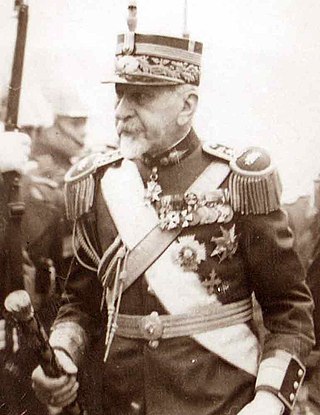
Constantin Prezan was a Romanian general during World War I. In 1930 he was given the honorary title of Marshal of Romania, as a recognition of his merits during his command of the Northern Army and of the General Staff.
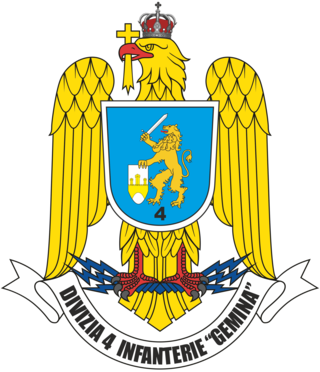
The 4th Infantry DivisionGemina is one of the major units of the Romanian Land Forces, with its headquarters in Cluj-Napoca. Until 15 June 2008 it was designated as the 4th Territorial Army Corps "Mareșal Constantin Prezan". It is the heraldic successor of the Fourth Army.

The 3rd Army was a field army of the Romanian Land Forces active from the 19th century to the 1990s. It fought as part of the German Army Group B during World War II, in Ukraine, the Crimea, and the Caucasus. General Petre Dumitrescu commanded the 3rd Army for much of that time.
The 16th Infantry Brigade was an infantry brigade of the British Army that saw active service during the Second Boer War and the First and Second World Wars.

The 10th Armoured Division was an armoured formation of division-size of the British Army, raised during the Second World War and was active from 1941–1944 and after the war from 1956–1957. It was formed from the 1st Cavalry Division, a 1st Line Yeomanry unit of the Territorial Army (TA) which had previously been serving in Palestine. The division was converted from cavalry to armour and redesignated from 1 August 1941.
The First Army was a field army of the Romanian Land Forces, active from 1916 to 2000. The successor of the First Army was the 1st Infantry Division.
The Fourth Army was a field army of the Romanian Land Forces active from the 19th century to the 1990s.

The 2nd Mountain Troops Brigade "Sarmizegetusa" is a mountain troops brigade of the Romanian Land Forces. The brigade was initially formed as the 2nd Mountain Troops Division on 1 July 1923. The unit distinguished itself in the campaigns of World War II from 1941 to 1945, receiving the nickname "Flint Division". It is now named after the most important Dacian military, religious and political centre. The 2nd Mountain Troops Brigade is currently subordinated to the 2nd Infantry Division and has its headquarters in Brașov.
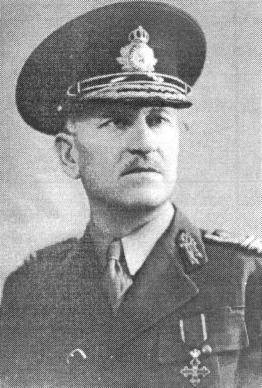
Constantin Constantinescu-Claps was a Romanian general during World War II who commanded the Romanian Fourth Army at the Battle of Stalingrad.

Eremia Teofil Grigorescu was a Romanian general who served as the commander of the 1st Romanian Army during the First World War. He also served as Minister of War in the Constantin Coandă cabinet.

Radu Korne was a Romanian Brigadier General during World War II.

The 146th Infantry Brigade was an infantry brigade formation of the British Army, part of the Territorial Force with the 49th Infantry Division. The brigade saw active service during both the First and the Second World Wars, and during the early part of the Cold War. The brigade was active from 1908 until 1967 when it was finally disbanded. The brigade was reformed in 1983, though with a much smaller and insignificant role before finally disbanding again in 1993.
Barbu Alinescu was a major general of the Romanian Armed Forces during World War II.
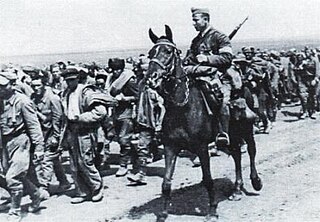
Operation München was the Romanian codename of a joint German-Romanian offensive during the German invasion of the Soviet Union in World War II, with the primary objective of recapturing Bessarabia, Northern Bukovina and the Hertsa region, ceded by Romania to the Soviet Union a year before. The operation started during the night of 2–3 July 1941 and concluded successfully after 24 days of fighting. Axis formations involved included the Romanian Third Army in the north; the German Eleventh Army and subordinated Romanian units in the center; and the Romanian Fourth Army in the south. The invasion was followed by a genocide against the Jewish population of Bessarabia.

The 20th Infantry Division "Friuli" was an infantry division of the Royal Italian Army during World War II. The Friuli was formed on 24 August 1939 by splitting the 20th Infantry Division "Curtatone e Montanara" into the Friuli and the 44th Infantry Division "Cremona". The Friuli was named for the region of Friuli, but based in Tuscany, where it also recruited most of its troops. The division's headquarter and its regiments, with the exception of the 87th Infantry Regiment located in Siena, were based in Livorno. The division served as occupation force on Corsica and fought German units after the Armistice of Cassibile was announced on 8 September 1943. The division then served with the Italian Co-belligerent Army and remained active into the early stages of the Cold War.

The 44th Infantry Division "Cremona" was an infantry division of the Royal Italian Army during World War II. The Cremona was formed on 15 September 1939 by splitting the 20th Infantry Division "Curtatone and Montanara" into the 20th Infantry Division "Friuli" and 44th Infantry Division "Cremona". The division was named for the city of Cremona. The division served as occupation force on Corsica and fought German units after the Armistice of Cassibile was announced on 8 September 1943. The division then served with the Italian Co-belligerent Army and remained active until the 1975 Italian Army reform.
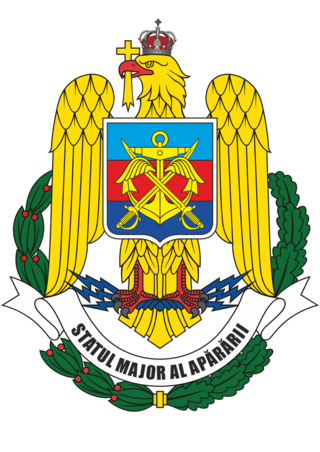
The Romanian Armed Forces are the military forces of Romania. It comprises the Land Forces, the Naval Forces and the Air Force. The current Commander-in-chief is Lieutenant General Gheorghiță Vlad who is managed by the Minister of National Defence while the president is the Supreme Commander of the Armed Forces during wartime.
The 144th Infantry Brigade was an infantry brigade of the British Army that saw active service in the First World War and again in the early stages of the Second World War before being reduced to a reserve brigade and remained in the United Kingdom for the rest of the war. In both world wars the brigade served with 48th Division.
References
- 1 2 (in Romanian) 165 Years of Existence of Romanian Artillery Archived 2011-08-26 at the Wayback Machine
- ↑ Romanian Army Groups